Abstract
When Prince Hall became Worshipful Master of Africa Lodge 459 his duties were far greater then marching in St John’s day Parades and burying their dead. The mark of a builder is the careful execution in laying out their work. The petitions to the Colonial Court of Massachusetts, for the abolition of slavery, formation of an educational platform and service to the community of Boston, were early examples of the social construct. Primus Trask Hall would serve as head master of the Normal School, in Boston, which later became the African Meeting House. The trestle board the Masons of Boston would serve as a blue print for the Prince Hall Masons of Florida.
Education
Joseph Robert Love was born in the Bahamas on the 2nd of October 1839. {1} After receiving his degree in Medicine from the University of Buffalo, he became a curate at the Episcopal Church located in Jacksonville Florida. While in Jacksonville, he became the 1st Grand Master of the Most Worshipful Sovereign Grand Lodge of Florida, from 1870-1872. He was a teacher at a private school located at the intersection of Adams and Catherine St. He began as a custodian and administrator at the Episcopal Church located on Church and Ashley St. {2} The eager teacher– later known as an apostle of black nationalism and Pan-Africanism and as Marcus Garvey’s inspiration– opened the doors of his classroom on Ocean Street in 1869. “Even at Trinity Church in New York City, Love’s appearance created somewhat of a sensation. Just after he returned to Jacksonville in December Young dismissed him from the Diocese of Florida and transferred the deacon to Savannah. Rumors of moral lapses seemed to follow Love, but other issues likely factored here. Beyond Young’s temerity in ordaining a black man as a priest, the young teacher had been circulating quietly to enroll area black men in secret masonic lodges. This was a harbinger, if not an early example, of Love’s future radicalism that fit perfectly into the heady atmosphere of Reconstruction-era Jacksonville.” {3}
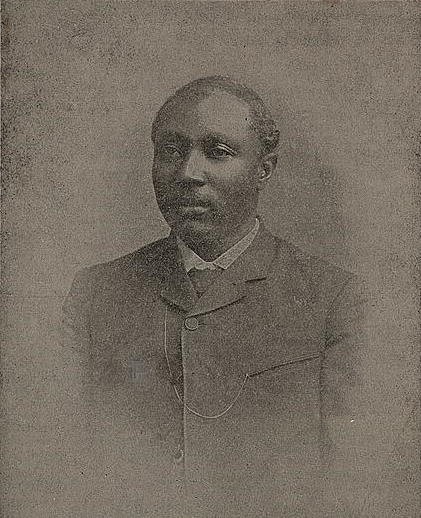
Library of Congress http://www.loc.gov/pictures/item/2005681141/
William Middleton Artrell was born in Nassau, Bahamas Islands in 1836. He served as a city councilman in Key West Florida and was a member of Union Lodge 48 in Key West Florida. Artrell was a Teacher and Principal at the Douglass School. The School was the 1st to serve black children in Key West. The school was named after Fredrick Douglass. He had visited the school during his visit to Key West in 1871. William Artrell served as the City Alderman 1st Ward 1875 {4} The heart and soul of the Florida grand lodge was William Middleton Artrell, who had not been born into slavery. He had received a sound basic education as a child in the British island of Nassau and became a teacher there. After he emigrated to Key West in 1870 he found work as a school principal and alderman. He gave up drink in 1874. During republican presidencies Atrell enjoyed a steady income from patronage appointments at Key West, first in the customs service and latter in internal revenue. During the interval of a Democratic Presidency he became a school principal and merchant tailor. While in Jacksonville he was active in the fight of the yellow fever epidemic. {5} In Jacksonville he would work with Dr. Alexander Darnes who served as Past Master of Harmony Lodge and Deputy Grand Master in 1893.
Photo Curtesy of Key West Library
Alexander Darnes was a slave born into the Smith Family, in St Augustine in 1840. General Kirby Smith was the last Confederate General to surrender. Darnes had nursed Smith back to health after an illness. He served with him till the conclusion of the Civil War. When he was emancipated, he attended Lincoln University (Pennsylvania) in 1876 and Graduated from Howard University Medical school in 1880. After graduation, he moved to Jacksonville Florida where he set up his practice. During the Yellow fever epidemic, when many doctors fled Florida, he stayed and helped the citizens both black and white. While practicing medicine two young men cleaned the floors of his office and where mentored by him. They were none-other than James Weldon and John Rosemond Johnson. {6}
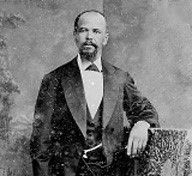
Photo Curtesy of Florida Memory
James Weldon Johnson was born in Jacksonville Florida on June 17th, 1871. His mother was Helen Louise Dillet, a native of Nassau, Bahamas, and his father was James Johnson. His father was a clerk at the Saint James Hotel in Jacksonville Florida. His Mother was a teacher at the prestigious Stanton school in Jacksonville Florida. The school’s history dates to the 1860s. It began as an elementary school serving the African-American population under the then-segregated education system. “Shortly after Emancipation, a group of African Americans from Jacksonville organized the Education Society, and, in 1868, purchased the property on which the Old Stanton school now resides. It was their intent to erect a school building to be known as the Florida Institute. Financial problems, however, delayed progress on the building until December of that year when the first school was built and incorporated through the aid of the Freedman’s Bureau. This wooden structure was named in honor of Edwin McMasters Stanton, President Abraham Lincoln’s second Secretary of War.” {7} After graduating Atlanta University, James returned home to Jacksonville. He became a teacher and principal at the Stanton School. He was a Past Master of Paul Laurence Dunbar Lodge 219. {8} He would also open a law practice with George Walter Wetmore. {9} James Weldon Johnson left a foot print in a path that many would follow. His poetry and legacy are still felt today. In his autobiography, he once referenced his initiation into “the freemasonry of the race” to describe his entry into “the best class of colored people” in Jacksonville, Florida.
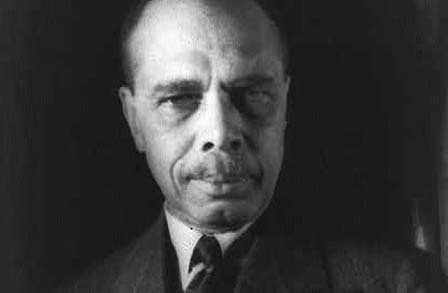
Poetry Foundation
Reverend Penn Brooke Braddock was a Past Master of Harmony Lodge #1. {10} He was also Pastor of East Jacksonville Church and St. Paul’s Church in La Villa. There he built the first brick church in Florida (AME) and paid for it. He materially assisted the Rev. W.P. Ross in erecting the Divinity High School building which was the pride of the Conference. It would later become Edward Waters College. He was the Presiding Elder of Jacksonville District, East Florida Conference in 1890. On March 15, 1870, under the leadership of Saint Paul’s first pastor, Reverend John R. Scott, Sr., construction of the first frame structure began. In 1883, Reverend P. B. Braddock built the first masonry structure. This sanctuary was the first masonry church owned by the African Methodist Episcopal Church in the State of Florida. Saint Paul was remodeled in 1906, under the pastorate of Reverend James Bennett.

John Robert Scott Sr. was the first Pastor of St. Paul A.ME Church and a prestigious member of the Florida house of representatives (Duval County) from 1868 – 1873 and 1879. He was an appointee of William J Purman of the Freedman’s Bureau. He and Harry Henry Thompson would serve as United States collectors at the port of Jacksonville. Thompson would serve as the 1st Grand Master of Union Grand Lodge of Florida followed by Rev. Scott. He was also a city councilman serving the people of La Villa from1877-1879. Scott would die, while in session, in the Florida House of Representatives. “Hon. John R Scott , Collector of the Port of Jacksonville, former pastor of the A.M.E. Church in Jacksonville, is a little man in stature he is evidently a big man in heart and brain. At the last State Republican convention, he came within one or two votes short for securing the nomination for Congress. He has done good work for both church and state since the close of the war, and is a man of ac-knowledge ability and influence” Christian Recorder December 1872 “Mr. Scott will likely be the next speaker of the Florida House of representatives. He is a good parliamentarian, and gives great promise of becoming a great power in the state.” {11}
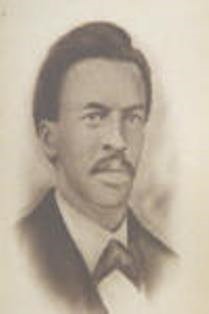
Photo Curtesy of MWUGL of Florida
John Robert Scott Jr. was born September 19th, 1862 in Columbia South Carolina. He was a graduate of Wilberforce University. Like his father, he was an educator, politician and minister. He served as the 1st president of Edward Waters College. He also served the Most Worshipful Grand Lodge of Florida in many capacities. He was a city councilman in Jacksonville from 1897-1899. “Rev Scott the great Hebrew scholar and one of the strongest young men Wilberforce has ever sent from her walls, is a successful teacher.” W.P. Ross. Florida Times union February 1889 “For four years he was the principal of the Divinity High School in Jacksonville.: he has been prominently known as a advocate of prohibition, and introduced in the Republican Congressional Convention in 1884 a resolution on temperance which served to almost break up the convention. {12} He died on February 18,1929 in Jacksonville Florida.
Colored School # 1 Fernandina
In 1880, a group of men led by H.B. Delaney led a petition for a permanent “Negro School” and the “Original Colored School No. One” opened on N. 11th Street in 1884 and served the community until 1827 when a new school opened on N. 10th Street and assumed the Colored School No. One designation. {13} Ray S. Delaney brother of H.B. Delaney had served on the City Council from 1870—1871 1880-1881. He was born in Georgia and was a brick mason in Nassau County. {14} The Following are members of the Fernandina City Council who served at the time of the petition through completion of the Colored School No. One
Samuel Petty Island City Lodge # 3 Fernandina Florida. Samuel Petty was born March 15. 1842 in Duval County Florida and worked as a carpenter in Duval and Nassau County. Petty would serve as a Fernandina Councilman for the years 1870-1872, 1875-1879, 1881-1882 1888-1889. He would latter be elected to the Florida House of Representatives 1873, 1874. 1875 (Nassau County) He was a Constitutional Convention Delegate in 1885 representing Nassau County. While also serving as a a councilman Samuel Petty was a lighthouse keeper for the Amelia Island Light House (1879 – 1880) In his later years of public service he would represent Nassau County as a delegate to the Republican National Conventions in 1884 and 1888. Past Master Petty was the acting Grand Treasure for the Most Worshipful Union Grand lodge of Florida in 1893
Fernandina Observer, August 1874
“The work of demolition fell to The Hon. Samuel Petty the present representative from this county, and that the young man did himself great credit by his plain and his earnest and indignant denial of the charges circulated by carpetbagger Liberty Billings. We should judge, leaving out those who were indifferent, that they audience stood four to one for Petty and against billings. {14}
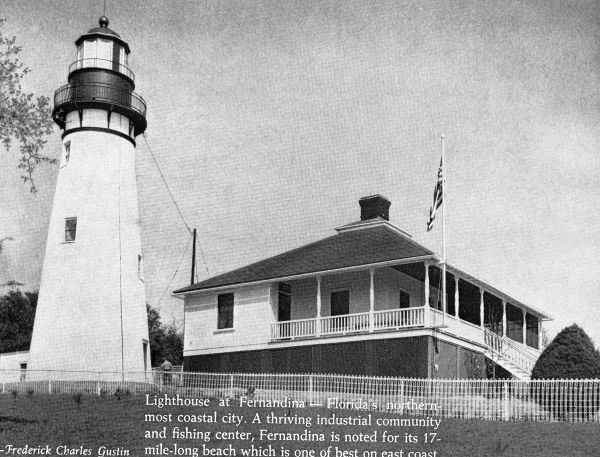 Curtesy Fredrick Charles Griffin
Curtesy Fredrick Charles Griffin
Riley Edward Robinson was an Methodist Episcopal Minister born in Lincoln, County Tennessee November 4th 1847. He worked in Nassau County as a carpenter. Robinson served the City of Fernandina as a Councilman from 1875-1879, 1883-1890 1892-1894. He was elected to the Florida House of Representatives 1883-1885. Riley Edward Robinson was a member of Island City Lodge # 3
Legislative biographer J.V, Drake wrote, “ Robinson was born a slave, he had no advantage of any early education: moved to Alachua County, Florida 1858 and remained there until the close of the war, he then moved to Duval County and served five years as an apprentice to the carpenters trade, moved again to Nassau County in 1870, and served three years in the Customs House. After emancipation as he could obtain in a night school and by self-culture. “ {15}
Port W. King was born in 1851 in Florida. He worked in Nassau County as a brick mason. He was a clerk and treasure for the city of Fernandina. In 1875-1876 he then became a assessor of taxes from 1878-1879 In the year 1883 he served as a city councilman until 1885. Port W, King was a member of island City Lodge #3.
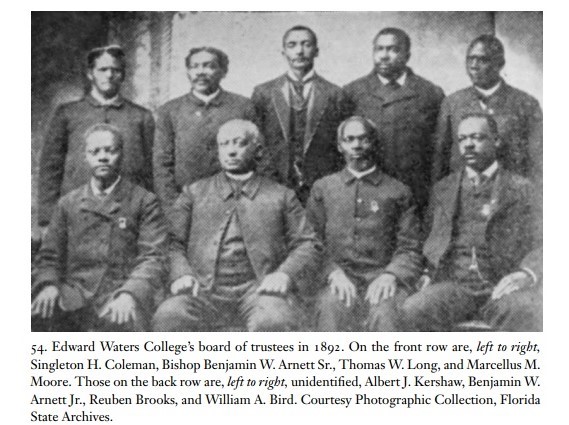
Curtesy Canter Brown Laborers in the Vineyard of the Lord.
Edward Waters College Board of Trusties 1892 would be compromised of 4 of the most prominent Masons in Florida.
Samuel Harrison Coleman was Elected Grand Master in 1888 in a contested Election he would serve for 6 months until he stepped down as Ruben S. Mitchell was elected Grand Master. In 1890 he was elected again until his untimely death in October 24th 1898 in a train accident 1898. He was born August 25th 1855, in Jackson Tennessee. He was the Presiding Elder of the A.M.E. Church in Live Oak Florida. He served on the Education Committee for the E.M.E Conference and had correspondence with Fredrick Douglass while he was at Wilberforce Academy.
He was bornin Jacksonville Florida January 10th 1839 He served with the Thirty Third USCI 1862-1865
He was a AME Minister Presiding Elder in Madison County and was a D.D.G.M for that district. He served in the capacity as Madison County Superintendent of Schools 1868-1869. He was elected to the Florida Senate and served the following years. 1873, 1874, 1875, 1877, 1879
Thomas Wentworth Higginson commanding officer of Thomas Long quoted him in vernacular on the liberating effect of becoming a soldier and how that experience prepared him for citizenship. Died October 25th 1917 Jacksonville Florida
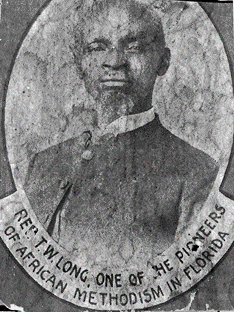
“If we hadn’t become soldiers all might have gone back as it was before; our freedom might have slipped through the two houses of Congress and President Lincoln four years may have passed by and done nothing for us. But now things can never go back, because we have showed our energy and our courage and our natural manhood. Another thing is, suppose you had kept your freedom without enlisting in this army. Your children may have grown up free and been well cultivated…… but it would have been always flung in their faces- Your father did not for his own freedom. And what could they have answered? Never can you say that to this African race no more. {16}
Reverend Ruben R Brooks who served as the Grand Trustee over the new Masonic Temple in Jacksonville Florida in 1912. He was the 1st Past Master of Sons of Solomon Lodge. He rose to the forefront of the civil rights movement in Jacksonville Florida. In 1901 over 50 years before Rosa Parks Andrew Patterson seated himself in the white only car of a black operated trolley car. This set off one the largest boycotts in U.S. History. Rev R. B. Brooks led the protest. The transportation systems were shut down in Pensacola Tampa and Jacksonville as a result of the protest. . This incident fueled racial tensions further. The arrest of Andrew Patterson and the subsequent Boycott headed by Rev, R,B. Brooks only galvanized the residents of La Villa.
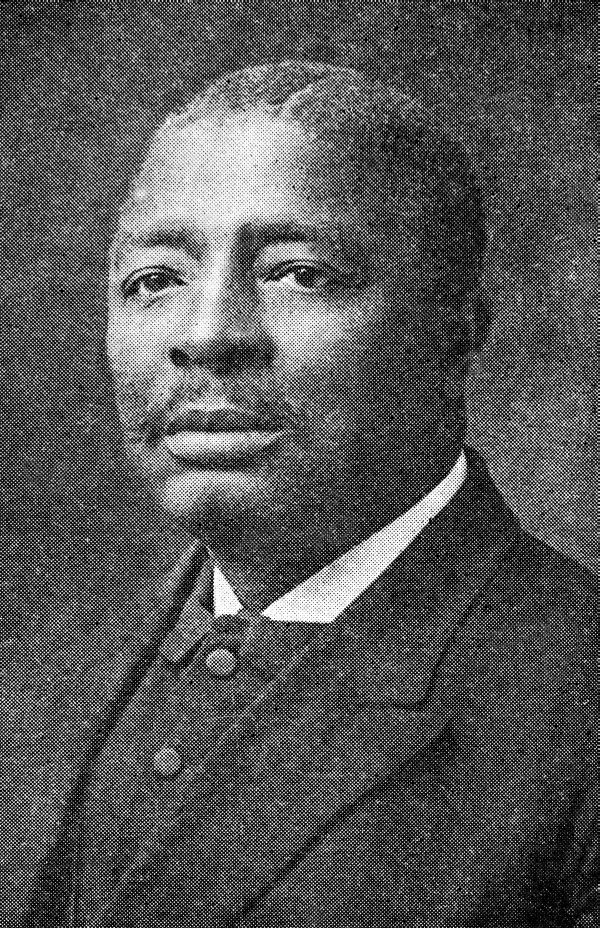
Cutesy Florida memory
Bishop Morris Marcellus Moore was a Pastor in Pensacola Florida and a member of the general conference of the A.M.E Church. He was the 27th bishop of the AME church. Born Nov. 15, 1856. He received his licensed to preach in 1876 in Quincy. Ordained deacon 1880 and elder in 1881. Elected sec. of the AME church in 1896 and bishop in 1900. Died Nov. 23, 1900 after serving as bishop for only 6 months. {17} He was unable to receive enough funds to start a Normal school in Pensacola. He was later reassigned to the Jacksonville District. Bishop Morris was a member of Excelsior Lodge and a District Deputy grand master over Escambia County. He also served as the Grand Chaplain for the Most Worshipful Union Grand Lodge of Florida in 1889.
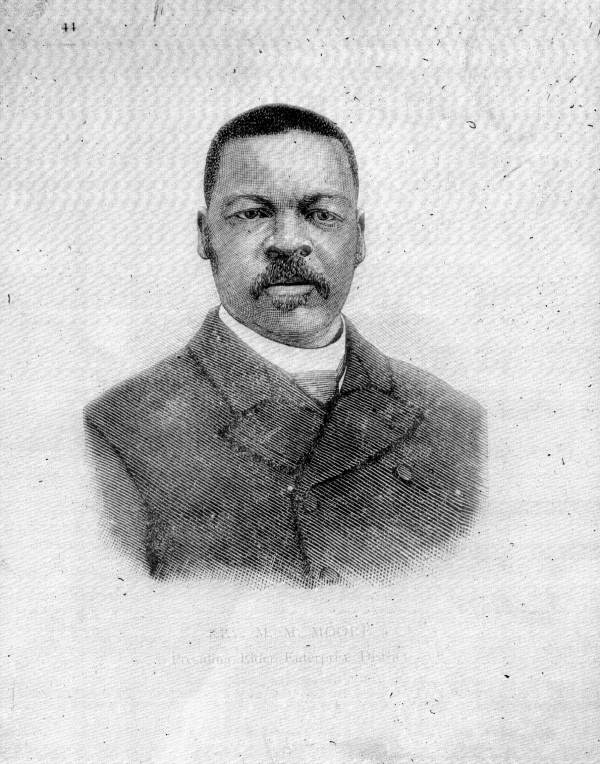
Florida Memory Black Past Remembered
Abraham Grant.
Abraham Grant was the acting Grand Master of the Union Grand Lodge of Florida, in 1879. He planted the seeds of education in Jacksonville Florida, but had a higher purpose. Grant would become one of the most influential black men in the country. He was a mentor to Booker T. Washington and Marcus Garvey. He would become the 4th Grand master in the State of Texas for prince hall Masonry and would push his education platform throughout the mid-west.
In response, many common people felt a need for something more than existing Methodist worship could offer. Affinity for Holiness teaching and practice in the upper echelons of the African Methodism, was rare, but some leaders, such as AME Bishop Abraham Grant, did have such an affinity. Which in Grants case may have been related to the fact, he was converted in a camp meeting in 1868. Grant was a prominent educator; vice president of Paul Quinn College, a founder of Payne Theological Seminary, a trustee of Wilberforce University and colleague of Booker T. Washington. He was also associated with Holiness preacher Amanda Berry Smith. {18}
At the time of his death he was the President of Western University. He also served on the Committee on Labor with Jesse Lawson under president Roosevelt. {19} Grant and Booker T. Washington rode in President McKinley’s coach as the visited the graves of fallen black soldiers of the Civil war. When Bishop Grant became ill, a resolution was sent to him from President Taft. Grants highest honor was his nomination to the Committee on Labor by President Taft. He was held in very high esteem by President Theodor Roosevelt by his reaction to the announcement of Bishop grants death. His legacy exceeded Prince Hall Masonry.
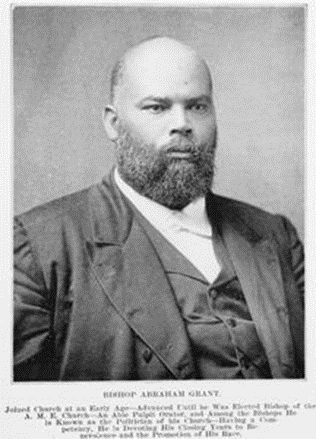
Most Worshipful Prince Hall Grand Lodge of Texas
“Bishop Grant’s official duties have carried him across the seas; twice he has been in Europe and he has presided over Conferences at Freetown, Sierra Leone, and Monrovia, Liberia, West Coast Africa. His shoulders have been thought broad enough to carry other weighty burdens, so he was for years the Presiding Officer of the Board of Trustees of Wilberforce University; for twelve years he was at the head of the Church Extension Board of the A. M. E. Church, and for a time one-third as long was President of the Publication Board of the A. M. E. Church (Philadelphia) and President of the Board of Trustees of Morris Brown College, Atlanta, Georgia; for three years he had the casting vote of the Board of Trustees of Allen University, Columbia, South Carolina, and Edward Waters College, Jacksonville, Florida.” {20}
National Library of Jamaica
- Jacksonville City Directory 1870
- Savannah Daily Republican, January 28, 1876
- http://www.keyslibraries.org/wp-content/uploads/2012/02/Black-History.pdf 10-17-17
- Race and Ethnicity in Secret and Exclusive Social Orders: Blood and Shadow edited by Matthew W. Hughey
- The Evening Telegram, Tuesday February 13th 1894
- Wikipedia James Weldon Johnson 11-12-17
- By-Laws Paul Laurence Dunbar Lodge 219.
- The Autobiography of an Ex-Colored Man (International Student Edition By James Weldon Johnson
- http://stpaulamejax.com/history.html 11-18-17
- Florida’s Black Public Officials 1867-1924 Canter Brown
- Florida’s Black Public Officials 1867-1924 Canter Brown
- City of Fernandina Beach proclamation February 2016
- Florida’s Black Public Officials 1867-1924 Canter Brown
- Florida’s Black Public Officials 1867-1924 Canter Brown
- Florida’s Black Public Officials 1867-1924 Canter Brown
- Florida Memory Black Past Remembered
- Black Fire: One Hundred Years of African American Pentecostalism By Estrelda Alexander
- Hidden Attraction: The History and Mystery of Magnetism Gerrit L. Verschuur –
- The Sons of Allen: Together with a Sketch of the Rise and Progress of Wilberforce University, Wilberforce, Ohio



